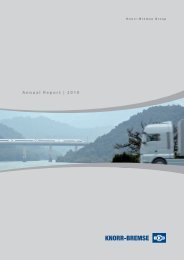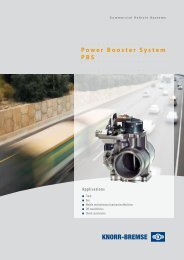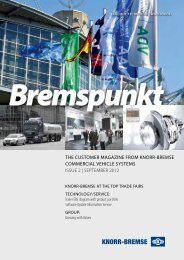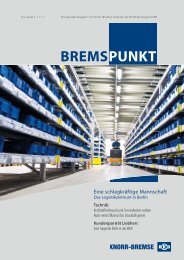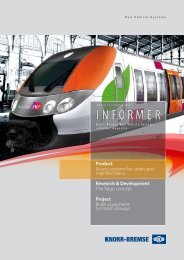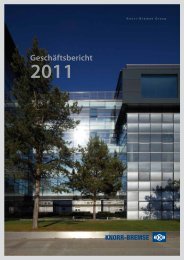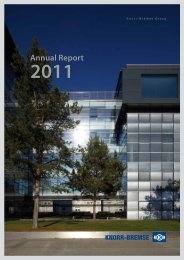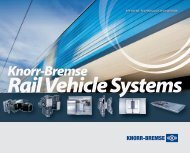Cover-Story Knorr-Bremse in North America Location Joint Venture ...
Cover-Story Knorr-Bremse in North America Location Joint Venture ...
Cover-Story Knorr-Bremse in North America Location Joint Venture ...
You also want an ePaper? Increase the reach of your titles
YUMPU automatically turns print PDFs into web optimized ePapers that Google loves.
14<br />
Edition 28 | December 2010<br />
“there has been a<br />
significant push for<br />
high speed Rail with our<br />
current adm<strong>in</strong>istration”<br />
Rich Bowie, President <strong>Knorr</strong> Brake Corporation, Westm<strong>in</strong>ster, USA, speaks<br />
about High Speed Rail traffic<br />
Mr. Bowie, markets almost all over the<br />
world are recover<strong>in</strong>g from the<br />
economical crisis – is the <strong>North</strong><br />
<strong>America</strong>n market do<strong>in</strong>g so, too?<br />
Rich Bowie: While slower than hoped,<br />
we are see<strong>in</strong>g <strong>in</strong>cremental<br />
improvements <strong>in</strong> the key <strong>in</strong>dicators<br />
<strong>in</strong> the US. The economic crisis <strong>in</strong><br />
<strong>North</strong> <strong>America</strong> and the world has had<br />
a significant impact on the transit<br />
market. The commercial vehicle and<br />
freight divisions were hit especially<br />
hard, requir<strong>in</strong>g that <strong>Knorr</strong>-<strong>Bremse</strong><br />
adjusts capacities to the new market<br />
conditions. The impact to the transit<br />
division was <strong>in</strong>itially <strong>in</strong> the aftermarket,<br />
but significant delays <strong>in</strong> nearly all<br />
planned major projects have been<br />
experienced.<br />
Public transit riders across the<br />
country are pay<strong>in</strong>g higher fares and<br />
face reduced service due to revenue<br />
shortfalls experienced by most public<br />
transit systems. Most public transit<br />
systems have seen flat or decreased<br />
fund<strong>in</strong>g from local, regional, state,<br />
and federal fund<strong>in</strong>g and nearly all<br />
were forced to raise fares or cut<br />
service.<br />
How does the price of gasol<strong>in</strong>e affect<br />
the popularity of <strong>North</strong> <strong>America</strong>'s<br />
railway services?<br />
Rich Bowie: When gas prices hit<br />
record highs <strong>in</strong> the US, nearly every<br />
Transit Agency reported dramatic<br />
ridership <strong>in</strong>creases. Freight traffic<br />
<strong>in</strong>creased, too. Unfortunately, as<br />
prices fell back, so did the <strong>in</strong>creased<br />
usage. Transit authorities took a<br />
double hit: besides hav<strong>in</strong>g significantly<br />
reduced federal and state fund<strong>in</strong>g,<br />
they have further reduced fund<strong>in</strong>g<br />
from gasol<strong>in</strong>e taxes.<br />
In which segments can tra<strong>in</strong>s really<br />
compete aga<strong>in</strong>st planes?<br />
Rich Bowie: Of course there is no<br />
competition <strong>in</strong> heavy haul and <strong>in</strong><br />
<strong>in</strong>tercity transit. But tra<strong>in</strong>s have<br />
demonstrated a competitive advantage<br />
<strong>in</strong> a number of the commuter markets,<br />
such as the <strong>North</strong>east Corridor. For<br />
example, with Amtrak Acela you can<br />
get from downtown Wash<strong>in</strong>gton D.C.,<br />
to Downtown New York City <strong>in</strong> less<br />
time door-to-door – with much less<br />
hassle – at a competitive price and<br />
much more flexibility. The challenge<br />
is to be able to construct these l<strong>in</strong>es <strong>in</strong><br />
other corridors.<br />
How does High Speed Rail play <strong>in</strong>to the<br />
future <strong>in</strong> <strong>North</strong> <strong>America</strong>?<br />
Rich Bowie: Clearly, <strong>North</strong> <strong>America</strong> can<br />
benefit from High Speed Rail. However,<br />
the obstacles are significant. To start,<br />
the exist<strong>in</strong>g <strong>in</strong>frastructure cannot<br />
support High Speed Rail. Besides the<br />
major issue of fund<strong>in</strong>g, there always<br />
seems to be issues with the routes such<br />
as land acquisition, environmental<br />
impact issues, and special <strong>in</strong>terest<br />
groups try<strong>in</strong>g to <strong>in</strong>fluence the decision<br />
process.<br />
How are the <strong>Knorr</strong>-<strong>Bremse</strong> products<br />
positioned <strong>in</strong> the growth <strong>in</strong> <strong>North</strong> <strong>America</strong>'s<br />
ambitious railway plans?<br />
Rich Bowie: One of the most significant<br />
developments <strong>in</strong> air brakes has been the<br />
<strong>Knorr</strong>-<strong>Bremse</strong> oil-free compressors.<br />
These compressors were designed<br />
specifically for the rail environments,<br />
not commercial products be<strong>in</strong>g adapted<br />
to tra<strong>in</strong>s. The success <strong>in</strong> the US is<br />
tremendous. Besides advantages <strong>in</strong><br />
ma<strong>in</strong>tenance costs (no oil to change)<br />
there is no oil passed <strong>in</strong>to the air that<br />
needs to be separated out and discarded.<br />
Our oil-free compressors are one of the<br />
many ways <strong>Knorr</strong>-<strong>Bremse</strong> demonstrates<br />
our commitment to go<strong>in</strong>g Green.


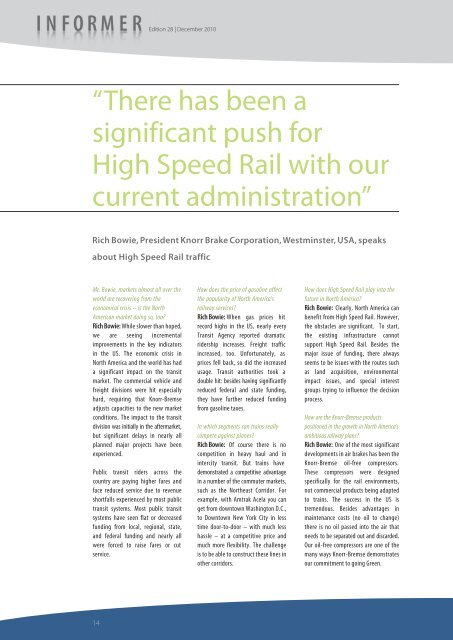
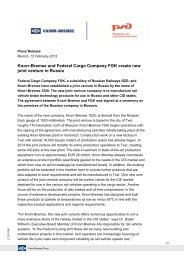
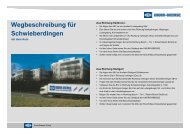
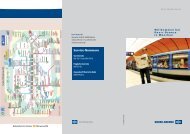
![Geschäftsbericht 2010 [PDF, 23 MB] - Knorr-Bremse](https://img.yumpu.com/9723397/1/185x260/geschaftsbericht-2010-pdf-23-mb-knorr-bremse.jpg?quality=85)

